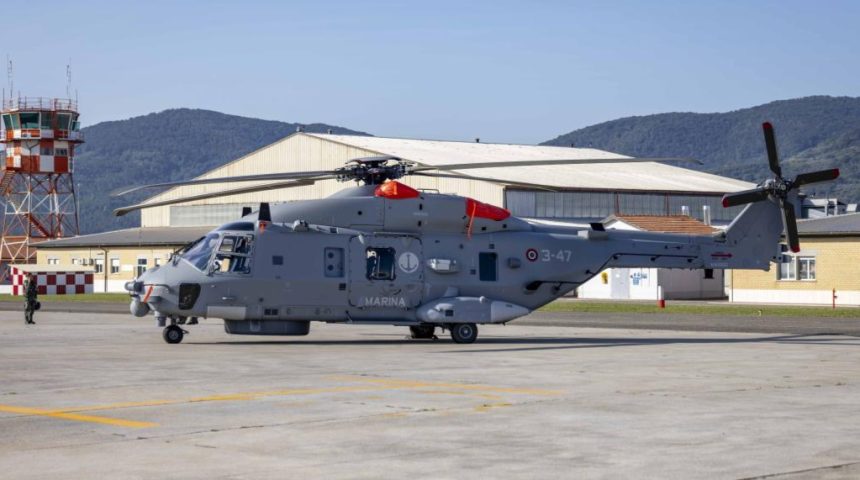The Italian Navy received 56 NH90 helicopters since 2011, which logged more than 35,000 flight hours in multiple operations in Italy and internationally.
The Marina Militare (Italian Navy) received its 56th and final NH90 helicopter during an official ceremony at the Maristaeli Luni Base attended by Italian Navy’s, Leonardo’s and NHIndustries’ representatives on September 29, 2023. The final helicopter is a SH-90A ASW/ASuW aircraft, assembled at Leonardo’s facility in Venice Tessera.
Since 2011, the Italian Navy took delivery of 46 SH-90A helicopters optimized for anti-submarine and anti-ship operations and 10 MH-90As optimized for tactical transport duties and special operations. The Italian Navy is one of the type’s largest operators and its whole fleet has logged in excess of 35,000 flight hours in multiple operations in Italy and internationally.
The fleet is distributed over the three main bases in Grottaglie, Luni and Catania, replacing the older AB-212ASW. The helicopters perform a wide range of missions also in support of the civilian population, such as search and rescue, medical evacuation, disaster relief and emergency response operations. They are also often involved in anti-piracy operations when embarked on Italian naval units operating abroad on international missions.
The completion of deliveries occurs as a unique Full Crew Simulation Training Centre is established and opened at Maristaeli Luni, featuring a dedicated Level D Full Flight Simulator of the type in full MR 1 configuration (therefore, representative of the latest avionics standard), all fully developed by Leonardo and tailored to the Italian Navy’s needs. The choice of the location is not casual, as Luni is the helicopter’s main operating base for the Navy and is used for the training of the crews.
Visualizza questo post su Instagram
“The completion of the NH90 deliveries and the handover of this one-of-a-kind simulation environment marks a major step forward, which further reinforces our long-established partnership with the Italian Navy,” said Gian Piero Cutillo, Leonardo Helicopters MD. “I want to thank all Navy and industry personnel who made these results possible. We now look forward to continuing this collaboration with the Italian Navy towards new important goals and capability enhancement to meet evolving requirements.”
The new simulation environment allows for the SH-90 and MH-90 crews (including both pilots and specialised personnel) to be trained with the highest level of fidelity and accuracy (1 simulation hour being equal to 1 real flight hour) to carry out missions in any kind of operational scenarios to the benefit of effectiveness, safety, efficiency, and sustainability. The system is suitable for further evolution in the future, such as the possibility to be linked to other simulation assets in order to develop joint and multi-domain networked mission training. Additionally, the Full Crew Simulation Training Centre will deliver training services to NH90 crews from other countries.
Mixed results internationally
More than 500 NH90 helicopters have been sold to 14 countries. However, not all its operators are fully satisfied. In fact, some of them, already decided to retire the European helicopter, with the most recent being Australia that grounded the MRH90 Taipan fleet after a recent deadly incident. On the other hand, some other operators like the Italian Army and Navy are not encountering any particular problem with their helicopters and are looking forward to employing the type for the years to come. Some other operators, like France and Spain, are even buying new NH90 to increase their fleets.
Despite the media hype, there might be a lot of reasons for this. Some eye-opening insights about the Australian experience with the type can be found in the posts on LinkedIn by Jamie Martin, who commanded the 5th Aviation Regiment of the Australian Army between Oct. 2018 and Jan. 2021. His public posts on the business social media platform and responses to the comments bring some clarity among the fog of “confusion and misguided speculation” surrounding the matter.
“It is easy to blame a platform and label it as inherently flawed. However, every platform is just one part of a more extensive system, and every system has its flaws. We design and can modify any system (platform, policies, procedures, training, contracts) with the right decisions. The challenge lies in owning up to past mistakes and acknowledging them to make the necessary changes – even if it means facing the consequences. This takes courage and good leadership,” Jamie Martin says in one of his posts.
You can read all Jamie Martin’s posts and comments and draw your conclusions. One of the most interesting things you will find in the comments thread is his take on the reasons why another operator, New Zealand, did not face the same difficulties as Australia.









